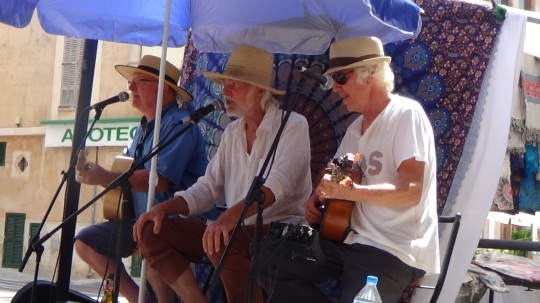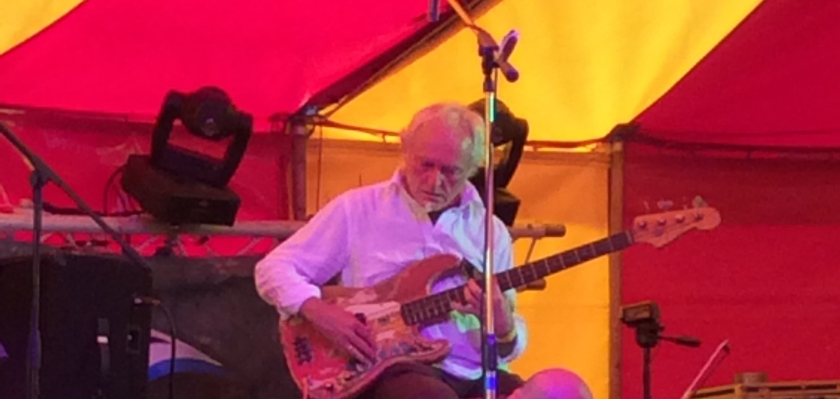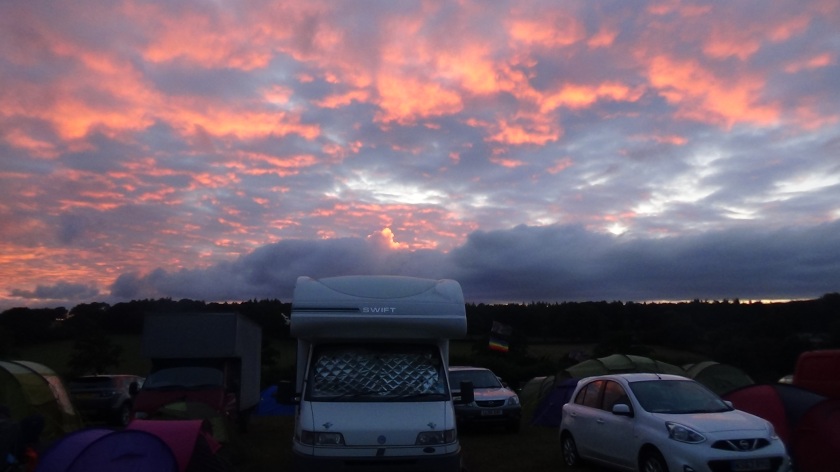Any student of Gong and the Canterbury scene doesn’t have to delve far, when following the history of the genre, before stumbling on references to Mallorca, or specifically, Deià, a small village on its west coast. In my case the introduction to Daevid Allen’s solo work was the 1977 album ‘Now Is The Happiest Time Of Your Life’, complete with flamenco intro, a track called ‘Deià Goddess’ and a drone named ‘I Am’, announced via a mule’s plaintive bray recorded outside Daevid’s then residence. It remains one of my favourite albums (see here).

Back cover to 'Now Is The Happiest Time Of Your Life', Daevid Allen
Deià was not only the village where Daevid, Kevin Ayers and Lady June had houses at various points, but it was home for significant early sabbaticals for Robert Wyatt and Didier Malherbe in the Sixties, and the place Richard Sinclair headed for after the break up of his relationship and Hatfield and the North in August 1975, an episode chronicled in detail in an interview in Facelift Issue 10. Somewhat more recently Deià was also the place Ultramariners Paul Hammond and Ian Cooper gravitated towards in the early Nineties following the receipt of their advance for ‘United Kingdoms’ (an album on which they collaborated with Robert Wyatt and Jimmy Hastings), giving up their day jobs to do so. Once in the village they met Lady June and were directed to Kevin Ayers’ house, a meeting that led to their collaboration on the reworking of Ayers’ song ‘Hymn’.


Postcards from Lady June, mid 1990s
Completely coincidentally, I have an indirect personal connection to Mallorca. My partner Georgina used to live on the island in the early Nineties and her daughter Rosana was born there. Soon after we met in 2005 both disappeared off to the island for the summer to stay with Rosana’s father, Miguel Angel, and I had the chance to go out too. A hire car enabled us to attempt a somewhat ham-fisted pilgrimage to Deià, where the intense heat drove us into a terraced café that would later host Kevin Ayers’ wake, followed by a quick stumble down what turned out to be the ‘Clot’, which housed both Allen’s and Ayers’ abodes, before ending up down at the Cala, a windswept and refreshingly undeveloped beach. Despite being largely unaware of these details at the time I vowed to return to explore properly, but the nearest I got to this was in 2016, when the onset of a serious illness scuppered the chance of visiting the island again on the day we were due to fly out.
In the meantime, the resurrection of my interest in writing about the Canterbury scene in 2016 coincided with me tracking down a book called ‘Tuning Up At Dawn’ by Tomás Graves. Tomás is the son of novelist Robert Graves, and like many of his siblings is also a writer, having published several books including Bread and Oil, regarded as an authoritative examination of Mallorcan and wider Mediterranean culinary traditions and cultural change. He is also, as we’ll see, a musician, as well as a publisher and printer. Prior to Tomás’ book, the main sources of information about the Canterbury/Deià connections were primarily Daevid Allen’s autobiographical ‘Gong Dreaming 1’ plus various newspaper/magazine articles (including some in Facelift). ‘Tuning Up At Dawn’ is a holistic assessment of musical history in Mallorca, but which includes as its first two chapters an account of the author’s early years growing up in an environment receptive to the influx of bohemian emigrees, and then more specifically examining those from the Canterbury axis. Without trying to spoil what should be an essential item on the bookshelf for all readers of this blog, there are nuggets in there about what the initial connection with Canterbury was, and a nickname for Robert Wyatt by which he was known to the Graves family during his first extended stay, alongside some of the more familiar accounts regarding the Daevid Allen’s original ‘seed vision’ which sparked the whole Gong mythology, and the story of Softs benefactor Wes Brunson, the original ‘Stoned Innocent Frankenstein’.


By another coincidence it turned out that Tomás is a neighbour of my stepdaughter’s father Miguel Angel, and mutual friend of several of my partner’s old associates and friends from Palma nearly 30 years ago (including an artist called Eli Sanchez, who recalls being a dancer at a Kevin Ayers/Daevid Allen gig on the island as a 14 year old, at an event we dated as probably 1975). And so I set up tentative plans to meet Tomás should the opportunity arise once in Mallorca.
In our extremely humble abode, a barely converted shepherd’s hut, in blindingly close heat (our task was to look after an enthusiastic dog with a penchant for identifying our children’s sandals as surrogate dog toys – local shoe-selling market traders benefitted as a result) we spent happy days on the beaches at Cala Mondrago, Es Trenc and Cala d’es Mor, and baked-out evenings looking up at a vast, starlit sky, enjoying the first of the season’s shooting stars, listening to the music emanating from across the fields from Porreres, which was ‘in fiesta’, part of a competitive inter-town phenomenon which Tomás describes in his book.
Having acclimatised to what would be our surrounds for the next 10 days, we had another stab at discovering Deià. This was an hour’s worth drive up on the north west coast of the island, nestled within an imposing mountain range above the cove. Despite what appear to be some fairly major traffic-easing infrastructure upgrading, including a colossal tunnel north of Palma through the mountains to Soller, even I could tell that Mallorca was busier than 15 years or so, and one result of this was that on arriving in Deià, and just beyond la Casa de Robert Graves, now a tourist attraction, we found that the road to the Cala was subject to a police road block, apparently as the result of the new-found popularity of the restaurant which provides the portal to the beach on account of it being one of the locations for the recent massive TV hit ‘The Night Manager’.

Georgina and myself, outside the Bananamoon Observatory, Deià
And so we parked up a little closer to the village, and, it being lunchtime, headed for a shaded spot to cool off. After an excellent lunch at Sa Font Fresca we wandered down the neighbouring ‘Clot’, the narrow lane which meanders towards the Cala, safe in the knowledge that Daevid Allen’s old residence, the second ‘Bananamoon Observatory’, would be the last house we’d find (just in case we were also armed with various identifying pictures of its glorious bouganvillea, courtesy of a post from Brian Abbott). Brian had also told us that Lady June had lived in the flats somewhere to the left – it was from C’An Renou that I’d received a whole host of postcards, tapes, artwork, her trademark calendars and entertaining correspondence at various points in the 90s. In amongst the odd café, the Deya Archaeological Museum and various quaint and characterful cottages, one of which sported a huge whalebone in its tiny garden, we would have also passed Kevin Ayers’ old house – something to check out next time, maybe.

Looking beyond The Bananamoon Observatory, Deià to the church on the hill
From the ‘Observatory’, through the magnificent flora, it is just possible to see the church, occupying, as is almost always the case with Mallorcan ecclesiastical settlements, pride of place and imposing its image on all that it looks down upon. Here, we had been led to believe, was a graveyard where various luminaries were buried, although a quick Google search revealed that the local cemetery was in fact at neighbouring mountain village Valdemossa, casting temporary doubt as to whether we would definitely find what we were looking for. A tiny graveyard, almost an afterthought alongside a fairly substantial church, initially did not reveal what we were looking for, although I did muse as to whether the Biblioni family plot had any connection to guitarist Joan who performed the magnificent Flamenco Zero on the aforementioned Daevid Allen album.

Kevin Ayers headstone, Deià churchyard
Then in a far corner, looking back on the village, we found a stone dedicated to Juan Graves, author and brother of Tomás, alongside that of their mother Beryl, Robert Graves’ second wife, and then down a short set of steps, a more ‘bohemian’ corner containing plaques for Kevin Ayers, his long-time guitarist Ollie Halsall and artist Mati Klarwein, amongst other colourful commemorations containing names I didn’t recognise. Others looking around the graveyard appeared also not to be there by accident. Ollie Halsall’s stone has two guitar dials attached to it, although one is currently missing, it would appear.
I’d contacted Tomás on our arrival in Mallorca, hoping to fix up a meeting – he’d suggested that we come along to his fortnightly gig at a restaurant in another central Mallorcan town, Campos, and have lunch together, towards the end of our stay, which was greatly looking forward to. Then, thanks some unwitting miscommunication from our part, we were cooling off back at base after a day out at the beach a few days after our Deià, and a car pulled up containing none other than Tomás Graves!
Tomás turns out to be an understated but extremely convivial man in his mid-Sixties (he is the youngest child of Robert Graves, fathered as the author approached a similar age). Born and bred in Mallorca (although some of his schooling was in the United Kingdom) he is passionate about Mallorcan tradition, food and culture in all its forms and a proponent of social justice more widely. It may have been the twinkle in his eye, but he reminded me slightly of satirist Peter Cook, albeit a somewhat leaner version… The impromptu visit was probably the best environment in which to speak to Tomás – he admitted the chapters in ‘Tuning Up At Dawn’ were very much anecdotal, rather than a posthumously researched chronology – as a young teenager in Deià when Robert Wyatt and then Daevid Allen arrived in the village the passages he writes in his chapter ‘The Road From Canterbury’ are the recall of someone who grew up with these exotic external influences as normality.

In conversation with Tomás Graves, Porreres, Mallorca
Conversation developed organically, as likely to veer off into discussions of his mutual connections with my partner Georgina, or a general commentary on Mallorcan culture, as much as pandering to my own Canterbury trainspotting needs. But we did talk about Didier Malherbe – how he’d turned up on in the village on his motorbike having travelled from Paris. Tomás still has a Cine8 film of his brother (Juan) and Didier larking around by the sea which he later sent me a copy of.
We talked of him witnessing Didier teaching himself the flute perched on the horizontal bough of a carob tree and the development of the sheep hut in which he lived within the Graves’ land, and Tomás later accompanying Didier, Gilli Smyth and Orlando Allen on bass when they performed at the Hay-on-Wye literary festival as it briefly decamped to Deià in the mid-Noughties. Of Lady June and her tiny flat in Deià which consisted of barely two rooms, one of which was stuffed full of her artwork, but which nevertheless appeared to always be crammed to the rafters with party-goers. Of doing his O Level Media project (over in England) and being able to choose for his resources back in Deià no less than Daevid Allen himself and his huge stash of International Times; being sent the ‘Love Makes Sweet Music’ single in a brown paper wrapper decorated by Daevid’s handwriting and pre-Gong drawings of his Captain Capricorn figure.
We also talked of Richard Branson’s relationship with Deià and the island, and hotels changing ownership as much as a consequence of dissolving personal relationships (some involving musicians) as of business sense. Of his first hand experience of Mati Klarwein’s construction of his huge artwork masterpiece ‘Annunciation’ which was later shrunk to form the album cover for Santana’s ‘Abraxas’. We also talked about Tomás’ plans to film a documentary about Kevin Ayers, his life in Mallorca and related topics, currently thwarted because a. Spanish television companies approached do not regard the subject matter ‘Spanish’ enough and b. because of the exorbitant price of re-screening archive video clips demanded by the appropriate record companies with who copyright resides.
Tomás has a keen personal involvement with music on the island which informs his writing – and is best known for his longtime involvement (on bass) with the band Pa Amb Oli (which provides most of the original Catalan title of his first book) but actually trained formally from the age of 7 with Bartolomé Calatayud, the Dean of classical guitar in Palma. He is a much called-upon guitarist for various projects: he cryptically mentioned that his band just recently been asked to provide backing band for what he called a ‘karaoke’ project for various visiting musicians, with a cast that has since been revealed to include Bobby Gillespie of Primal Scream, Bob Geldof, Damon Albarn and Paul Simonon, on the occasion of the 50th birthday party of the latter’s wife – the deal was that Tomás and co would choose the songs and the guest musicians would provide the vocals.

Tomás con Gas: Steve Lambert, Gus Pollard, Tomás Graves - Ca'n Serraller, Campos
The gig we eventually saw on Saturday was an extension of his Tomás Con Gas duo with singer Gus Pollard, now augmented by guitarist Steve Lambert. Gus and Steve have personal connections to Daevid Allen and Kevin Ayers respectively which I won’t go into here. Under more baking sun, and accompanied by the best food on the island, the threesome worked through 3 sets of approaching an hour each, encompassing an eclectic and comprehensive mix of folk and blues covers from Little Feat to John Martyn via Curtis Mayfield, a meticulously arranged and performed set, featuring a wonderful voice (Gus), some fine picking (Steve) and accompanying guitar and harmony vocals from a very assured Tomás. A joy to behold as the musicians sang for their dinner and more.

Gus Pollard, Tomás Graves
This was almost the perfect way to finish our holiday before we left the next morning: a fantastic meal set against a most agreeable musical backdrop, and further vignettes of Mallorcan life shared as the day wore on. And more than a hint that this might not be the end of the story…















